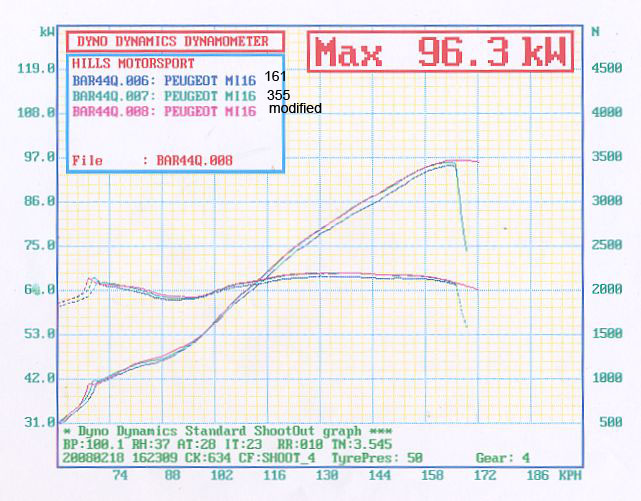
BOSCH MOTRONIC ECU
The 1.9L Mi16, 309 GTi16V and the Citroen BX16V were all fitted with variations of the Motronic ECU. Early cars were fitted with the 2 row version (4.1), later to be replaced with the more advanced 3 row version (1.3). The part number easily identifies each version, 0 261 200 XXX. The last three digits being the difference.
There a three basic versions:
2 row - no knock sensor, no lambda sensor (eg 125, 139)
3 row - knock sensor, no lambda (eg 354, 355)
3 row - knock sensor and lambda sensor (eg 158, 161, 167)
Improving or "Chipping" the Motronic 4.1 and 1.3
I now offer both 2 and 3 row chips to compliment my Stage I and II cams. The data for the files came from dyno sessions done over recent years, from a range of standard and modified engines.
There is generally little to be improved upon in remapping naturally aspirated engines and the 1.9L Mi16 is no exception. The 2 row 139 is probably the most poorly mapped of the available ECU's, although I have not seen a 119 or 125. Impressive increases in midrange torque can be realised with careful attention to the ignition curve.
In the later 3 row versions (158, 161, 354, 355 etc.), both the fuel and ignition mapping is very good. So do not expect the same increases.
Below is dyno graph of three runs, all done on the same car, one after the other, with just enough time between runs to change the ECU. The engine has a 3 row ECU, Stage I inlet cam and 10.8:1 compression ratio, but otherwise standard. To keep the modifed chip honest, it was dynoed last, when heat soak would have been a detrimental factor. Power is at the wheels.

You can see from the graph that my chip offers little in improvement over a 355 ECU, other than the extended rev range to 7500. This also translates to the same feel on the road. To test the low-mid range more thoroughly, I did a series of 4th gear roll ons from 2500 to 4000 on the highway. The average for both chips was the same at approx. 8.0 secs. Whilst the dyno indicated 1kW more from the modified chip (you have to look hard), you'd have to admit that's experimental error. A big grin comes from the extra 400 rpm however, where you can utilise the extra power available over a wider range. This would be even more pronounced with the Stage II cam.
The difference between the modifed and 158/161 chips is more noticeable. You can really feel the extra 4kW at the top end, and the fatter torque spread available over most of the range.
Opening The Case and Changing The Chip (2 row 139)
Opening The Case and Changing The Chip (3 row 158, 161, 167, 355)